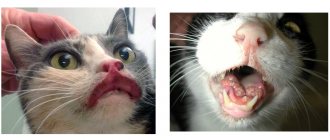Balancing, developing speed, intimidating enemies and even thermoregulation - all these functions in cats are performed by the tail. It contains many nerve endings, which is why the tail is often called an indicator of a pet’s mood.
However, serious damage to it can lead to a fracture. How to recognize an injury in a timely manner? What actions should I take? Specialists from a veterinary clinic in Moscow talk about everything in more detail.
See this article:
Common causes of fractures Signs of a fracture Types of fractures Diagnosis by a veterinarian Treatment: methods and effectiveness
- Gypsum
- Amputation
- Drug therapy
Prevention
Common causes of fractures
A cat's tail is an anatomical extension of the spine, so any damage can lead to serious consequences for the entire body. Most often, the animal is injured at home. For example, if there are small children in the house, then the likelihood of damage increases (dangerous games, tail pulling, etc.).
That is why it is necessary to explain to young children that they are putting the cat in danger by handling it carelessly. Sometimes even simple pranks that seem completely harmless can lead to serious damage to the animal.
Other causes of tail fractures in cats:
- being jammed by a door,
- accidental collision (for example, by a vehicle or bicycle),
- pulling with force,
- falling from a great height,
- attack on the tail,
- other mechanical damage to the lower back or tail itself.
Symptoms and diagnosis
If the owner suspects damage to the tail of his pet, it is necessary to immediately find out how serious the problem is and whether it is really a pearl. Knowing the main symptoms of a tail fracture, the owner will be able to respond adequately :
- The organ at the site of possible injury will be bent. Depending on the severity of the damage, the depth of the bend will depend. If the pearl is indeed present, then a kink in the tail will be evident.
- The tissue around the affected area will be swollen.
- Presence of a bleeding wound.
- Any touch to the injured part will cause severe pain to the animal.
- Increased temperature of the damaged organ and the whole body.
After an injury, the owner should keep an eye on the cat, because a fracture of the tail is not always accompanied by a clear bend. It may appear smooth, but the fact that the injury is serious will be indicated by the pet’s behavior and various signs.
The cat's gait will definitely change: it becomes uneven and staggering. The tail will drag along the ground in an unnatural manner. With a very severe injury, even failure of the hind legs is possible. The cat may behave aggressively because the injury causes him severe pain.
The animal may have involuntary urination, and sometimes there is uncontrolled excretion of feces. But such symptoms do not always indicate that the cat has a broken tail. This is possible if the spine is damaged.
If it is confirmed that the pet has a tail fracture, he needs urgent hospitalization at the veterinary clinic. Doctors will use x-rays to diagnose and prescribe the necessary treatment. In difficult cases, if an animal’s tail injury has led to paralysis, an MRI, ultrasound, and blood test may be prescribed. Also, if the clinic has such a service, electromyography is prescribed. This is a method by which they determine how well nerve impulses travel through the muscles and peripheral nerves, that is, they determine the severity of the injury.
Signs of a fracture
The signs of a broken tail are so noticeable that you will spot them right away. The first thing you need to pay attention to is a pronounced visual fracture of the tail. This will be immediately noticeable, so you can quickly respond and seek help from a veterinary clinic in Moscow.
Other signs indicating a tail fracture:
- strong pain,
- increase in body temperature,
- tail inflammation,
- lack of muscle support (the pet’s tail just hangs down),
- paralysis,
- numbness of the tail,
- urinary incontinence,
- the pet's inability to go to the toilet on its own.
These symptoms are characteristic of a tail fracture. However, a serious condition will be accompanied by other (general) symptoms. These include worsening appetite, general malaise and weakness, refusal to play, and lethargy.
When a fracture occurs, the pet drags its tail and cannot control it. This condition is called “dead tail”. It often leads to a decrease or complete loss of sensitivity in the hind legs. All this disrupts the coordination and balance of the animal’s movements.
If you see that your cat's tail is broken, then do not hesitate - contact your veterinarian ! This will quickly relieve pain and avoid possible dangerous consequences.
Symptoms: how to determine if there is a problem?
Externally, you can detect when a cat’s tail hurts due to a fracture. The strength and characteristics of symptoms depend on the type, location and severity of the injury. The general signs are as follows:
- loud meowing, signaling that the cat has broken its tail and it hurts a lot;
- a visually discernible bend in the injured area, while the organ is lowered or bent and does not rise;
- a wound on the cat's tail or an open tear from where the vertebrae are visible;
- increased temperature, swelling and redness of the skin in the tail;
- inability to lift the tail and move it, as it is very swollen;
- blood in urine;
- urinary and fecal incontinence;
- lameness and problems with coordination;
- paralysis, particularly of the hind legs;
- massive bleeding.
Types of fractures
Closed tail fracture . It differs in that the integrity of the soft tissues is preserved. There is no visual damage, but the cat experiences severe pain and loses the ability to control its tail. This type of fracture is usually diagnosed after being pinched by a door or being run over by a car.
Open tail fracture. It is noticeable immediately because the integrity of the skin is compromised and wounds are present. This type is most often diagnosed during a fight with other animals (for example, dogs) and a fall from a great height.
Broken tail. It occurs when the kitten’s skeletal system is not yet fully formed. The vertebrae bend because there is strong traumatic pressure. This form occurs when the tail is pulled back.
Regardless of the type of fracture, you should immediately consult a doctor. Self-medication is unacceptable!
Home care for a sick pet
No special care measures are required, but the cat is physically unable to lift its tail, “shackled” in plaster, when visiting its litter box. This means that you will have to clean it daily. If you have such an opportunity, the “posterior regions” of your pet should be washed daily with warm water and baby soap (but the plaster cast should not get wet).
It is recommended to repeat x-rays approximately every two weeks to assess the speed and success of the regeneration processes. When bandages, splints, staples, etc. are removed, it is advisable to massage the affected tail daily. This will quickly restore the sensitivity of the organ and its flexibility.
A relatively “harmless” tail fracture is a fairly serious injury. The sooner you contact your veterinarian and begin treatment, the less likely you are to develop severe complications.
Diagnosis at the veterinarian
The diagnosis can be made during the initial examination, since a fracture or other serious injury to the tail will be immediately noticeable. The doctor’s main task is to determine which part of the tail was damaged.
To do this you will need:
- visual inspection,
- owner survey,
- radiographic examination,
- blood and urine tests.
All this will allow you to find out how serious the damage is and what treatment the animal will need.
Treatment: methods and effectiveness
The treatment for an injury depends on the extent of the damage and the location of the wound. If the fracture is diagnosed closer to the tip of the tail, then no major surgical intervention will be required.
If an open fracture is diagnosed, treatment will take longer. It involves removing bone fragments and severe bleeding. It requires immediate stopping, as it poses a threat to the health and life of the pet.
To remove fragments and examine the destroyed vertebrae, drugs for local anesthesia are used. This will ensure the safety of the animal and prevent possible discomfort during the intervention.
To prevent infection from entering the body through damage, the doctor will prescribe a course of antibacterial therapy.
Gypsum
Typically, for fractures and severe dislocations of the caudal vertebrae, plaster is prescribed. An alternative to plaster is applying a fixing bandage. Plaster is not very convenient for a pet, so it is used in rare cases. Most often, veterinary clinics use fixing bandages applied directly to the pet’s tail.
After applying a cast or bandage, you will need to use a special collar. On average, the duration of such treatment is about 21 days. In especially severe cases, the period of wearing the fixing bandage is increased. A mandatory requirement is to monitor healing using x-rays.
Amputation
This is a radical treatment method, used quite rarely. It is used only for special indications, which include tail paralysis or an open fracture at the very base of the tail. The surgery is performed under full anesthesia, so your pet will not feel pain or discomfort.
After amputation, quite a long rehabilitation will be required, taking from 14 to 20 days. Possible consequences of injury include the inability to go to the toilet on your own. In this case, the owner will need to manually massage the bladder and help the pet empty its bowels.
Drug therapy
It is not used as an independent treatment, but is prescribed separately (in addition to plaster or amputation). Drug therapy involves taking a number of medications necessary to restore the pet’s body and strengthen it. If necessary, vitamin and mineral complexes are prescribed.
Remember that only a doctor can prescribe effective treatment. Do not risk the health of your beloved pet - entrust its treatment to specialists.
Prevention
The most important thing is to handle animals carefully. There is no need to pull or catch the cat's tail, especially if it is trying to escape. Do not leave windows open if there is a pet in the house. The best solution is to install a net in advance to prevent falls from great heights.
These simple rules will help you avoid such unpleasant and dangerous situations as a broken tail. However, in any case, do not forget that help will need to be provided to your pet immediately!
Why is a broken tail dangerous for cats?
An anatomical feature of the tail is the fact that it consists of a large number of bones and vertebrae and is replete with the presence of nerve endings and blood vessels. The role of the tail in a cat’s life is difficult to overestimate: with its help, she determines distance and balances when passing through narrow surfaces.
Any animal can be injured, especially if it is a kitten or cat that often walks outside











